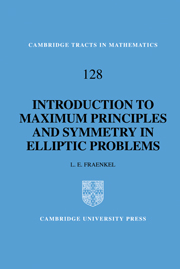Book contents
- Frontmatter
- Contents
- Preface
- 0 Some Notation, Terminology and Basic Calculus
- 1 Introduction
- 2 Some Maximum Principles for Elliptic Equations
- 3 Symmetry for a Non-linear Poisson Equation in a Symmetric Set Ω
- 4 Symmetry for the Non-linear Poisson Equation in ℝN
- 5 Monotonicity of Positive Solutions in a Bounded Set Ω
- Appendix A On the Newtonian Potential
- Appendix B Rudimentary Facts about Harmonic Functions and the Poisson Equation
- Appendix C Construction of the Primary Function of Siegel Type
- Appendix D On the Divergence Theorem and Related Matters
- Appendix E The Edge-Point Lemma
- Notes on Sources
- References
- Index
3 - Symmetry for a Non-linear Poisson Equation in a Symmetric Set Ω
Published online by Cambridge University Press: 05 February 2010
- Frontmatter
- Contents
- Preface
- 0 Some Notation, Terminology and Basic Calculus
- 1 Introduction
- 2 Some Maximum Principles for Elliptic Equations
- 3 Symmetry for a Non-linear Poisson Equation in a Symmetric Set Ω
- 4 Symmetry for the Non-linear Poisson Equation in ℝN
- 5 Monotonicity of Positive Solutions in a Bounded Set Ω
- Appendix A On the Newtonian Potential
- Appendix B Rudimentary Facts about Harmonic Functions and the Poisson Equation
- Appendix C Construction of the Primary Function of Siegel Type
- Appendix D On the Divergence Theorem and Related Matters
- Appendix E The Edge-Point Lemma
- Notes on Sources
- References
- Index
Summary
The simplest case
In this chapter we prove theorems about positive solutions u of Δu + ƒ(u) = 0 in a bounded symmetric set Ω. Theorem 1.2 (which asserted spherical symmetry and monotonicity of u in a ball) appears as Corollary 3.5, with slightly less smoothness required of ƒ now than was demanded before, and again as Corollary 3.9, (b), for a function ƒ that may be discontinuous. Our main concern is with sets Ω and solutions u that are symmetrical only under reflection in a single, fixed hyperplane; results for this situation imply those for balls, as Lemma 1.8 may have indicated already.
Two definitions set the stage as regards ƒ and Ω.
Definition 3.1 Let W ⊂ ℝ. A function ƒ : W → ℝ is locally Lipschitz continuous iff, for each compact set E ⊂ W, there is a constant A(E) such that
the number A(E) is called a Lipschitz constant of ƒ|E.
The function ƒ is uniformly Lipschitz continuous iff a single Lipschitz constant A(W) serves for all s, t ∈ W.
For example, if W = (0, ∞) and ƒ(t) = t−1 + |t – 1| – t2, then for the compact subset [δ, n] of (0, ∞) we may use the Lipschitz constant
But no single Lipschitz constant will serve for this function and for all s and t in (0, ∞).
Definition 3.2 Recall from Definition 1.7 that xμ, κ denotes the reflection of any point x ∈ ℝN in the hyperplane Tμ(κ).
- Type
- Chapter
- Information
- Publisher: Cambridge University PressPrint publication year: 2000



